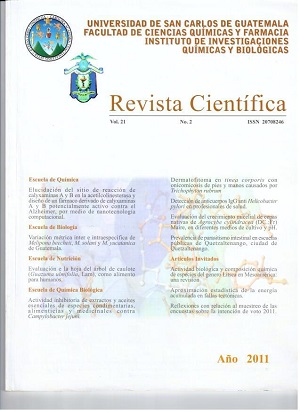Evaluation of caulote tree leafs (Guazuma ulmifolia Lam) as human´s nutrient.
Keywords:
caulote, acute toxicity tests, acceptability, proximal chemical analysis, sensory descriptionAbstract
ABSTRACT
“Intra and interspecific morphological variation of Melipona beechei, M. solani and M. yucatanica from Guatemalaâ€
The main purpose of the study was to analyze the morphometrics variations of the heads and right forewings of the three species of Guatemalan stingless bees of the genus Melipona. We used multivariate statistical analyses at infraspecific and interspecific levels to evaluate Melipona beecheii, M. solani and M. yucatanica populations.
A total of 305 specimens of the LENAP´s entomological collection were used. These adult female workers were collected at different localities (meliponaries) across Guatemala. From each of the localities 10 heads and right forewing were dissected and scanned, and we pointed 14 homologous landmarks of the head and 12 landmarks of the wings for the traditional morphometry analysis.
The results at interspecific level showed significant head and wing shape differences between the three species, supporting the previous taxonomic classification of the stingless bees of Guatemala in M. beecheii, M. solani and M. yucatanica (Ayala, 1999). The intraspecific comparisons showed distinct patterns of differences: M. beecheii showed no significant differences, suggesting a strong colonies movement across the country since the Mayan civilization and still moving until the present day, and some degree of gene flow between neighboring localities. Within M. solani and M. yucatanica there is a separation between populations from different geographic origins. Population from Nuevo Progreso, San Marcos, formed a separate subcluster in the case of M. solani, and two populations from Jutiapa reveal significant differences. Ecological local adaptations could be responsible for these morpohological divergences.
References
Arencibia, D.F. et al (2003). Algunas consideraciones sobre la determinación de la toxicidad aguda. Revista Toxicología en línea. Recuperado de http://www.sertox.com.ar/img/item_full/22001.pdf
Charley, H. (1987). Tecnología de Alimentos. Procesos químicos y físicos en la preparación de alimentos. Editorial Limusa Noriega. México, 757 p
Francis, J.K. (1995). Guazuma ulmifolia Lam. Guácima Sterculiaceae Familia del cacao. (en línea). Recuperado de http://www.fs.fed.us/ global/ iitf/Guazumaulmifolia.pdf
Greenfield, H. y Southgate, D.A.T. (Ed). (2003). Datos de composición de alimentos. Obtención, gestión y utilización (2a ed.). Roma: Organización de las Naciones Unidas para la Agricultura y la Alimentación.
Jackson, M.L. (1970). Análisis Químicos de Suelos
(2da ed.) Barcelona, España. Omega.
Kirchgessner, M. (1987). Tierernährung. Alemania, Technischen Universität München, Institut für Ernährungsphysilogie. Pp. 21 -24.
INCAP-OPS (2006). Tabla de composición de alimentos de Centroamérica. Recuperado de http://www.tabladealimentos.net/tca/TablaAliment os/inicio.html
Ministerio de Educación, Secretaría de Seguridad Alimentaria y Nutricional. (2009). Tercer Censo Nacional de Talla en escolares del primer grado de educación primaria del sector oficial de la República de Guatemala. Guatemala 4 al 8 de agosto de 2008.
p
Ministerio de Salud Pública y Asistencia Social, et al (2009). V Encuesta Nacional de Salud Materno Infantil 2008-2009. Pp 44-46. Recuperado de: http://www.ine.gob.gt/np/ensmi/Informe_ENSMI2
_2009.pdf
Watts, B. et al. (1992). Métodos sensoriales para la evaluación de alimentos. Otawa Centro Internacional de Investigación para el Desarrollo. 170 p.

